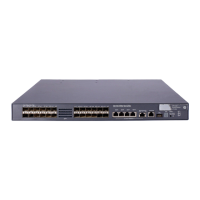214
To do… Use the command… Remarks
Enter Layer 2
Ethernet
interface view
interface interface-type interface-
number
15. Apply the
QoS policy
to the
outgoing
packets of a
Layer 2
Ethernet
interface
Apply the policy
to outgoing
packets
qos apply policy policy-name outbound
Enter port group
view
port-group manual port-group-name
16. Apply the
QoS policy
to the
outgoing
packets of a
port group
Apply the policy
to outgoing
packets
qos apply policy policy-name outbound
Use any approach.
The global configuration
is effective for all
interfaces. The
configuration made on an
interface is effective only
for the interface.
For more information about the acl, classifier behavior, if-match, qos apply policy, qos apply policy
global, qos policy, remark dot1p, rule, traffic behavior, and traffic classifier commands, see the ACL and
QoS Command Reference.
An Ethernet frame header ACL identifies application protocol packets by protocol number. An IPv4
advanced ACL identifies application protocol packets by IP port number. DCBX Base Protocol Rev 1.0
identifies only application protocol packets by protocol number and advertises TLVs with protocol number
0x8906 (FCoE) only. DCBX Base Protocol Rev 1.01 supports identifying application protocol packets by
both protocol number and IP port number, does not restrict the protocol number or IP port number for
advertising TLVs, and can advertise up to 77 TLVs according to the remaining length of the current packet.
Configuring ETS parameters
ETS provides committed bandwidth. The device uses ETS parameters to negotiate with the server adapter,
controls the server adapter’s transmission speed of the specific type of traffic, and guarantees that the
transmission speed is within the committed bandwidth of the interface. In this way, no traffic loss occurs
due to congestion.
To configure ETS parameters, you must configure the 802.1p-to-local priority mapping and WRR queuing.
Configuring the 802.1p-to-local priority mapping
To configure the 802.1p priority mapping:
To do… Use the command… Remarks
1. Enter system view
system-view —
Enter Layer 2
Ethernet interface
view
interface interface-type
interface-number
2. Enter interface
view or port
group view
Enter port group
view
port-group manual port-group-
name
Required.
Use either command.

